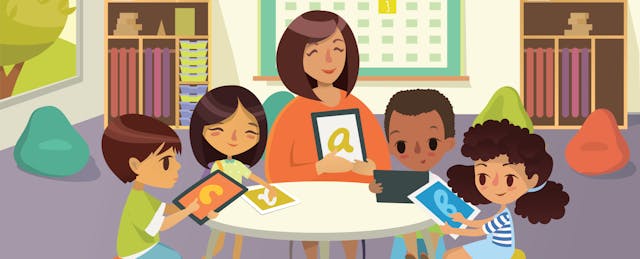We’re a military family, which means my five-year-old has already lived in four states. By my calculation, he has experienced seven different daycare, preschool and elementary school classrooms. While the classrooms centers, teacher ratios and playground equipment may be different, every center but one made the same comment to us during registration: “And, of course, we don’t do any screen time.”
Kids live in a world where they see technology all around them. For better or worse, the adults in their lives are using it all the time. I love that preschool classrooms are often a place where children dive into the hands-on experiences of building, touching surfaces, singing songs and stomping their feet, but do they have to be completely guarded from technology? I would argue that preschool is a place where we can thoughtfully introduce technology and, more importantly, model appropriate and informed uses of digital platforms.
Digital Games Can Encourage Full-Body Play
There’s a strong feeling that digital technology makes kids too sedentary, but what if games can encourage kids to go outside, play, and observe more of the world around them? Games that use the camera can help kids mimic the movements of creatures (ex: Wild Kratts’ Going Batty) or encourage them to go on a scavenger hunt in the real world (ex: Nature Cat’s Great Outdoors app). The exciting thing about mobile technology is that it can be used to get kids moving
Digital Content as a Prompt for Communication and Conversation
Recently, I watched a demo of a technology that allows children to communicate with their parents during the school day—Message from Me, from Carnegie Mellon University, allows preschoolers to use a tablet to take pictures of their school creations or projects, then record a voicemail-like message about the event. The photo and audio message are then texted to the parent, giving them a chance to hear about their children’s experiences in real time. I love how this prototype models for children how the technology can be used to make important social connections. My guess is that these images prompt more meaningful conversations with parents over the dinner table than the usual “what did you do today?” line of questioning.
The truth is, any digital content can be a prompt for conversation with students. As with other classroom activities, digital experiences should be limited to a specific amount of time, “cleaned up” when complete and ideally discussed with the child or as a group. What did you see? How did you overcome that challenge? Is it a game you would tell your friends to play? These conversations help model to young children that media is something to talk about with others, and to think about critically.
Digital Games Can Provide Insight Into a Child’s Learning Process
Obviously the first question to tackle when we think about digital technology use in the classroom is finding content that can be validated as truly educational, in addition to being safe, high-quality and age-appropriate. The app stores are full of products in an Education category, but these are rarely vetted or researched. In the early childhood area, I find that sources like Common Sense Media can help you search and navigate trusted sources to find content to meet your needs.
But beyond selecting content that is educational and engaging for preschool children, good content can also be insightful to educators and caregivers. After all, if the activity is teaching a child core concepts, can’t it also communicate the child’s progress to the grown-ups in their lives?
Game developers know that you can learn a lot about a player’s skills by looking at the back-end data: when did a player pause? When did a player make a series of mistakes before finding the right answer? Working with developer and research partners, the team at PBS KIDS, where I work, asked if we could apply this type of game data analysis to academic learning.
WGBH in Boston produced a series of Curious George games focused on preschool math, and the research firm West Ed confirmed in pre- and post-tests with eighty preschoolers that these games were successful in introducing and building early numeracy skills. The CRESST team at UCLA, which focuses on data analysis and student assessment, helped us dig deeper. They created a neural net to use a child’s gameplay data to predict that child’s score on a subset of the TEMA-3 early math assessment. The accuracy of the computer’s prediction of that child’s score based on playing Curious George games was astonishing.
The UCLA team who analyzed the data believes that games like these could measure a child’s cognitive learning better than a standardized test can. Imagine how 15 or 20 minutes of engaging gameplay could help support other activities in the classroom. Can it give teachers and parents insights to help better focus individual learning time? When paired with other math activities in the classroom, can games like these help kids practice core concepts and solidify key skills?
Teachers of four- and five-year olds can play a unique role in showing kids (and their parents) how phones and tablets can provide quality content that can be meaningful to education, prompt fun conversations with the people they love, and— importantly—be used and put away, just as we put the blocks back in the corner when we’re finished playing.


